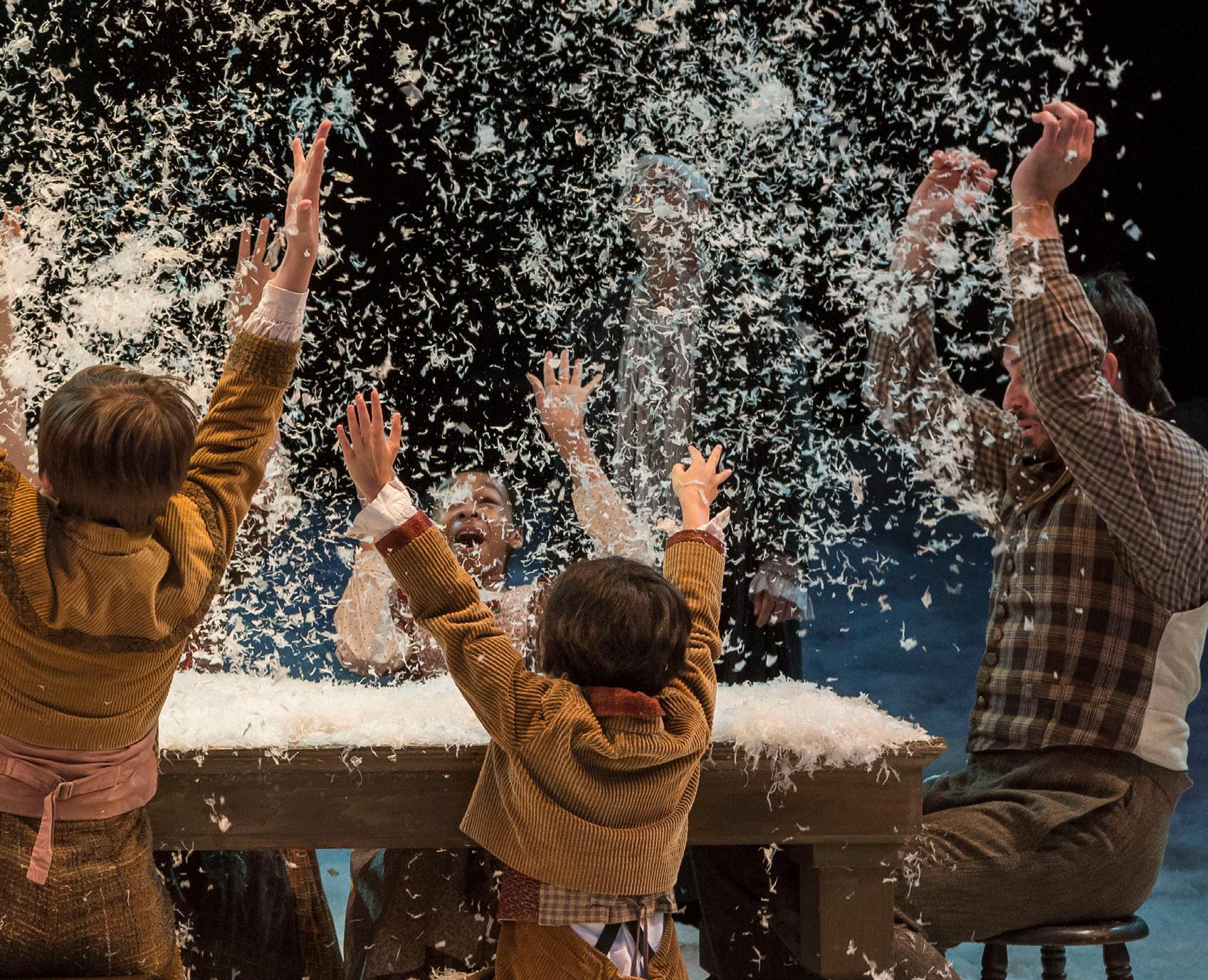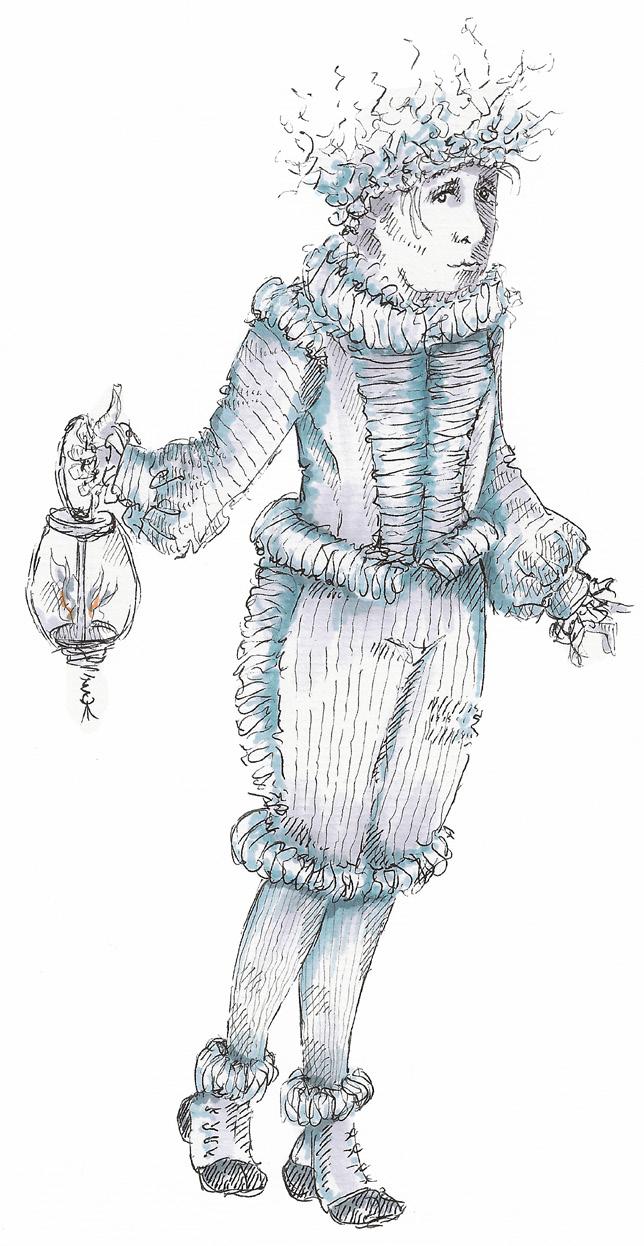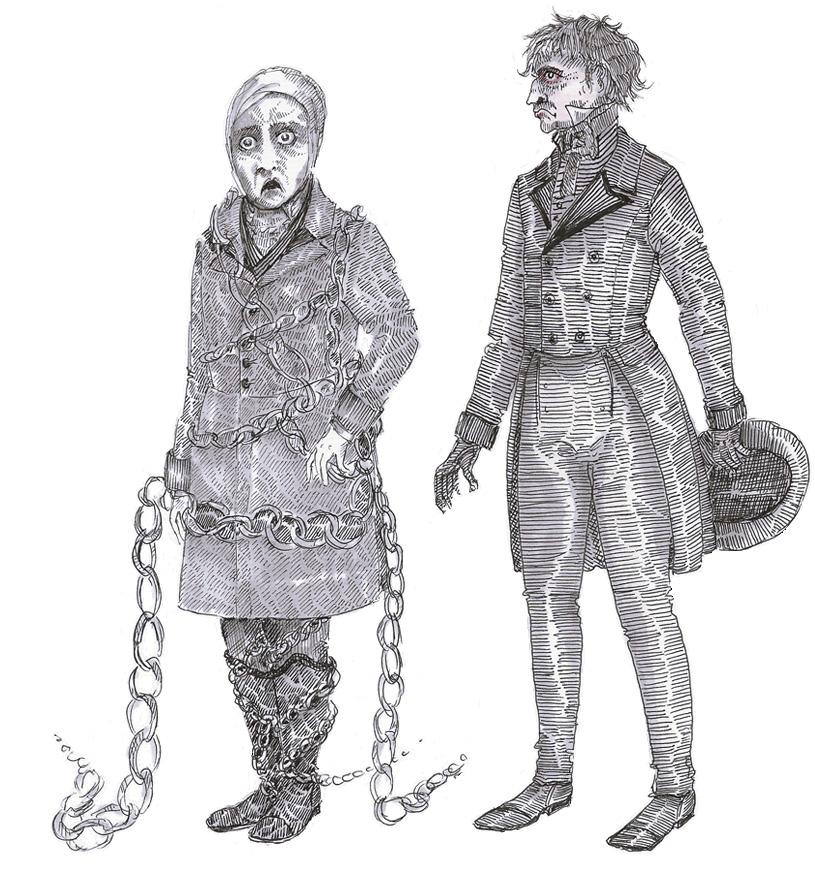
15 minute read
A Christmas Carol
ONEAMERICA MAINSTAGE NOVEMBER 23 – DECEMBER 26
ARTISTIC
Director ________________________ JAMES STILL
Scenic Designer_______________________
RUSSELL METHENY Costume Designer _______________________ LINDA PISANO Lighting Designer _____________________ MICHAEL LINCOLN Composer ____________________________ MICHAEL KECK Dramaturg_________________________ RICHARD J ROBERTS Stage Manager _____________________ ERIN ROBSON-SMITH* Assistant Stage Manager __________________ BECKY ROEBER*
ARTS PARTNERS
REVIEWS!
Share your review on social media by tagging us at @IRTLIVE, using #IRTLIVE or by emailing REVIEWS@IRTLIVE.COM
PHOTO CREDIT (SET ONLY):
SCENIC DESIGNER: Russell Methany LIGHTING DESIGNER: Michael Lincoln
SEASON SPONSOR
SEASON PARTNER
SEASON SUPPORT
making the arts happen
Original artwork by Tasha Beckwith
Margot Lacy Eccles Margot Lacy Eccles Artistic DirectorArtistic Director Managing DirectorManaging Director
THE CAST
CHRISTMAS EVE
Storytellers ___________ THE COMPANY Ebenezer Scrooge _____ ROB JOHANSEN* Bob Cratchit _______ RYAN ARTZBERGER* Fred _______________ WILL MOBLEY* Felicity __________ NINA JAYASHANKAR Marley’s Ghost _____ RYAN ARTZBERGER*
CHRISTMAS PAST
Ghost ______ MARIA ARGENTINA SOUZA* Child Scrooge ________ QUINTIN GILDON Fezziwig ______ DAVID ALAN ANDERSON* Young Scrooge ________ WILL MOBLEY* Mrs. Fezziwig _____ JENNIFER JOHANSEN* Belle ___________ NINA JAYASHANKAR
CHRISTMAS PRESENT
Ghost ________ DAVID ALAN ANDERSON* Mrs. Cratchit __ MARIA ARGENTINA SOUZA* Tiny Tim ___________ QUINTIN GILDON Penelope____ MARIA ARGENTINA SOUZA* Prudence ________ JENNIFER JOHANSEN* Topper __________ RYAN ARTZBERGER*
CHRISTMAS FUTURE
Ghost ______________ WILL MOBLEY* Pawnbroker ____ DAVID ALAN ANDERSON* Charwoman ______ JENNIFER JOHANSEN* Laundress ________ NINA JAYASHANKAR
CHRISTMAS DAY
Poulterer’s Son _______ QUINTIN GILDON
SETTING
England. The Eve of the Industrial Revolution. APPROXIMATE RUN TIME: 2 hours, including a 15-minute intermission
ACKNOWLEDGMENTS
Choreographer: Nicholas A. Owens Special Thanks: Katie Schuman, Karaline Feller, Matt Branic, Darrin Gowan Understudy for Scrooge: Ryan Artzberger Dance Captain: Maria Argentina Souza Choral Captain: Will Mobley Swings: Daniel Martin, Devan Mathias, & Marnie Moore Lighting Design Assistants: Madeleine Hebert & Bentley Heydt
* Members of Actors’ Equity Association, the Union of Professional Actors and Stage Managers in the United
States. The director is a member of the Stage Directors and Choreographers Society, a national theatrical labor union. The scenic, costume, and lighting designers are represented by United Scenic Artists Local 829, IATSE.
Photography and recording are forbidden in the Theatre. The videotaping of this production is a violation of
United States Copyright Law and an actionable Federal Offense.
COMMUNITY
After a monumental year without it, A Christmas Carol seems more vital than ever: more necessary, more comforting, more chilling, more hopeful. If you had told me two years ago that we would take an 18-month break from producing live theatre due to a world-wide pandemic, I would have thought you’d been reading far too much dystopian fiction; yet that’s exactly what happened. Our relationship to A Christmas Carol did not go away easily: until the bitter end of our season reconfiguring a year ago, we hoped against hope that we could manage some kind of stripped down Carol even in the midst of the pandemic. That’s how strongly we feel about the redemptive power of this story. But as union issues mounted, and the CDC and our local health authorities kept our city shut down, we realized that we were hoping in vain; and a virtual production of this piece simply didn’t seem worthwhile. You just need to be in the room with it. So instead, we pivoted to make what became our joyous holiday offering, This Wonderful Life: a one-man retelling of the Capra film, magnificently created by this year’s new Scrooge, Rob Johansen. Mercifully, that show allowed our audiences to celebrate the holiday season with theatre art—on a screen, but powerful nonetheless. Still we vowed that we’d find our way back to our beloved Dickens as quickly as we could.
Among the gifts of that first COVID summer of 2020 (who ever thought there would be a second?) was a few weeks in which our artistic staff worked on rethinking the Carol script. First, we focused principally on reducing the cast size: 16 actors in a rehearsal room or even onstage felt utterly unsafe. Soon, however, we began to rediscover how many hidden gifts lurk below the surface of Dickens’s wonderful novella. There were bits of language, unused in the past, that seemed utterly prescient to our particular time; little shifts that we had made through the years that no longer seemed worthy; things we had interpolated over the years that now seemed unnecessary; gorgeous chunks of Dickens that we’ve never spoken on stage that we wanted to hear. When we put the novella itself under the microscope of our scrutiny, we saw how we could scrape the barnacles off a beloved text and begin to see it anew. We could
BY JANET ALLEN, MARGOT LACY ECCLES ARTISTIC DIRECTOR

see that the story was like a banked flame, springing back to life. It held, and holds, much power to move us, to shake us; to make us examine ourselves, our commitment to community, and our ability to truly see each other.
What does living in community mean? What are our obligations to one another? These questions lie at the core of the journey the ghosts take with Scrooge in an attempt to redeem him from his narrow-minded, isolated, solitary lifestyle. And these same questions are eerily prescient in our own time. We have certainly endured an unprecedented dose of isolation in the past 20 months. How has this experience made us more narrow-minded, more afraid of people unlike us, less generous to those whose needs are even greater than ours? These are the things we are deeply considering and discussing as we make a new/old A Christmas Carol .
I am more delighted than I can say that James Still, our playwright-in-residence, has agreed to direct this year’s production. He begins this new journey with a new Scrooge, Rob Johansen. Both men have a good deal of experience with this story. James has seen every production during his 24 years with us, and has been a wise and welcome counsel. Rob has played every male role in the show except Scrooge, and probably knows all the female roles just in case! But it’s Rob’s spirit, his love of the story, and his immense skills that will be what we all gather to see this year. He’ll be supported by a former Scrooge, Ryan Artzberger, and several other actors who have played in our Carol many times, as well as some exciting newcomers. The village of actors for the Carol has never been more important, as we return to the essence of Dickens’s language and purpose.
So welcome back to A Christmas Carol. I imagine that you real diehards watched one of the many movie versions last year (maybe more than one); but there is no substitution for sitting in a room together listening raptly to live actors speak these words and take this journey toward a healed community. Let’s all take that journey seriously and emulate it in our lives, even in our times of apparently deep divisions. We all share a humanity, so let’s find that common ground of good!


CHANGE
BY JAMES STILL, DIRECTOR
“Everything changes, nothing is lost.…” That phrase (roughly translated from Latin) is from Ovid’s ancient poem known as Metamorphoses. Ovid’s acknowledgment about the inevitably of change and the possibility of transformation is at once wise and complex—and during these past many months of working on our new production of A Christmas Carol, I’ve repeated that phrase over and over. As an artist, part of my job is to keep my eyes open, to not turn away, to greet every day as an anthropologist, fortune teller, and change-maker.
For many years I’ve been a grateful audience member to the IRT’s beloved version of Charles Dickens’s A Christmas Carol. And while I’ve had opportunities to direct the play, I’ve never felt drawn to it as an interpreter because I was never convinced I had anything significant to bring to a production. This year is different. This year I said yes because of an intuitive desire to spend time with the story and its characters, to make meaning out of Dickens’s words and images, to contribute something hopeful even when everything feels dark. So here I am, finally, directing A Christmas Carol.
There are many givens that come with the IRT’s exquisite version of A Christmas Carol. The concept comes with the production. We are in a snowfield. We are witnesses to a story being generously shared by a company of actors. It’s a ritual and a tradition. What does tradition mean in times of uncertainty? Answers to that question have been part of what we’re exploring (again) in this year’s Carol. It took Charles Dickens a mere six weeks to write his novella—much less time than it takes us to make this production every year.
Even with the known givens handed to any director of the IRT’s Carol, there are a surprising number of unknowns that require months of meditation and inquiry. I’ve taken many long walks while in lively (imaginary) conversations with Charles Dickens. He’s been patient with me, generous with some of his responses, yet also playfully mysterious and withholding. His answers have often been questions, such as “What’s urgent about it now? What does the story mean to YOU???” And “You say you’re the director—but what’s your relationship with the collaborators and audience that will be your partners in storytelling?” I found a clue in the preface of his published novella, where Dickens refers to himself as “faithful friend and servant.” That’s not so different from how I think of myself as the director tasked with sharing this story as theatre. It’s in that humble spirit that I come to our production this year.
We are in a snowfield. We’re also very much in a theatre. Designer Russell Metheny once described his scenic design as “a theatre with a hole in the roof, and the stage has filled with snow.” It’s a beautiful image beautifully rendered by the IRT artisans who make our production possible every year. For the actors it means there is literally no place to hide. They are always on stage, often speaking directly to the audience, and always inviting us to collaborate in the unfolding of the Carol as a parable about the hard work of kindness and generosity.
At its heart, A Christmas Carol is a story about redemption. Dickens subtitled his novella “A Ghost Story of Christmas,” and as a writer, I understand that choice as subtle instruction: a ghost story can go wherever it needs to go in an instant; it is in constant motion, a story that easily moves both back and forward in time. There is something bold in the idea that it’s possible for a broken man, disconnected from his community, to CHANGE, to reset his moral compass and priorities, and to vow to start again fresh and new. The question that the story wrestles with from the beginning is whether or not Scrooge will actually have the courage to engage with his life in a meaningful way to make those difficult changes possible. It’s the ultimate story of being given a second chance.
So here I am, standing on the shoulders of all of the artists who have made meaningful versions of Dickens’s story in the past. For you, dear audience, there will be much that seems familiar: some of your favorite moments will show up right on cue. And simultaneously, there will be much that seems new—some of which I hope might become new favorite moments. “Everything changes, nothing is lost.” For the first time, Rob Johansen steps into the iconic role of Scrooge, which is a treat just waiting to happen. Rob will be joined by seven other brilliant actors who will gather in our snowfield as your neighbors, carolers, storytellers, and fellow humans sharing the same air. Never has that seemed so poignant to me. There are big and subtle changes in all of the designs (I’ll let you discover or guess), and designers, cast, and crew bursting with rich relationships to the IRT’s Carol—as well as those who are coming to it for the first time. I suspect that those circumstances will reflect the audience as well: many of you have embraced our production as part of your own family traditions; others are coming to it for the first time.
We gather to watch this story every year because we want to believe in redemption. We want to believe that if a broken man like Scrooge can experience a profound change of heart, then maybe we can too. We gather around this story because we believe there are some stories worth experiencing again and again. I need this story this year more than ever. Everything changes, nothing is lost. —James Still, a faithful friend and servant

It’s ironic, but as a scenic designer the thing I love most is great performances. I love creating an empty space in which great performances happen. That’s what this set is all about: an empty field of snow in which wonderful actors tell a wonderful story. When I see something on stage that is not what it is and looks like something else—that to me is great theatre.
Well of course, the first thing is the snow. That enormous field of white offers a technical challenge to a lighting designer. It’s harder to create isolated lighting effects; everything just bounces all over the place. But I also have unique opportunities, such as creating silhouettes against the snow. In terms of design, the snow functions very much like a sky drop—it’s a blank canvas on which I can paint any color. This production does not rely on theatrical “effects.” It’s all about the magic created between the actors and the audience. There are always new discoveries to make in the snow. It’s an unnerving yet exhilarating process.


This is a story that audiences know well. I re-read the novel to focus on character descriptions. Dickens’s work sheds light on issues of poverty, family, loneliness, and compassion. He writes about the industrial grime and soot of London in his day. The distressing of the costumes and the overall feel of the Cratchit family reflect these conditions. Class division is clear. Mrs. Cratchit is poor, getting fabric from the rag pickers of the streets. She is probably quite skilled in sewing and may even use pin tucks, embroidery, and other surprising details to liven up her family’s meager clothes. Our ghosts align closely with the descriptions in the novel. I also found great influence in John Leech’s original illustrations. The story presents a series of emotional experiences for Scrooge: Fezziwig’s party is a warm, jovial memory of the country, while Fred’s more urban and sophisticated party is something Scrooge has never attended. Both occasions hit home, demonstrating that for Scrooge to have a happier future, he must first deal with the issues and problems of his past and present.
During the holiday season, bells of every size find their rightful place in the soundtrack of our lives. Bells are everywhere, summoning and gathering people together, ringing out for donations, jingling at the end of a stocking cap, and announcing rituals and celebrations. I am fascinated by the magic and weight bells add to our experiences. Meanwhile, the holiday season also announces its arrival with familiar melodies of traditional hymns and carols. So when I was asked to join the Dickens creative team, two ideas emerged: the musicality of bells and the intimate sound of carolers. Together these themes might offer a positive counter-narrative for Ebenezer Scrooge in some instances, while highlighting Dickens’s timeless darker themes in others. All nicely packaged in a holiday ghost story. The musicality of bells and community voices quickly became the foundation for the music I am presenting with this season’s production of A Christmas Carol.

CHARLES DICKENS AUTHOR
TOM HAAS PLAYWRIGHT

The works of the great English novelist Charles Dickens are not only great literature, they are also cracking good reads, with oneof-a-kind characters and stories that both tug at the heartstrings and leave readers breathless with excitement. But the author’s purpose went beyond mere entertainment; his books were almost always designed to alert his readers to the wretched conditions of England’s poor and destitute. Born in 1812, Dickens suffered an impoverished childhood that provided plenty of grist for tales of debtors’ prison and rat-infested factories. Yet despite this poverty and his lack of formal education, he rose from legal clerk to newspaper columnist to best-selling author by the age of 24. During his lifetime, his books—Oliver Twist, Great Expectations, David Copperfield, and many more—were wildly popular, not only in England but also around the world; most are still in print. When A Christmas Carol was published in 1843, the holiday was not widely celebrated in England; the book inspired such a revival that the author became known as Father Christmas. In his later years, Dickens made almost a second career of public readings of this beloved novella. Long before he died in 1870, he was hailed everywhere as the greatest writer of his age. Tom Haas was artistic director of the IRT from 1980 until his untimely death in 1991. Prior to his association with the IRT, he was artistic director of PlayMakers Repertory Company in Chapel Hill, North Carolina. He was associate director at Yale Repertory Theatre and head of the Acting-Directing Program at Yale University, where his students included Henry Winkler, Sigourney Weaver, and Meryl Streep. At the IRT, Tom directed 40 productions, including memorable renditions of A Midsummer Night’s Dream, Mourning Becomes Electra, The Skin of Our Teeth, The Cocktail Party, Six Characters in Search of an Author, and, of course, A Christmas Carol. IRT audiences also saw his stage adaptations of Frankenstein, Dracula, and The Three Musketeers, as well as the musical Operetta, My Dear Watson and dozens of Cabaret shows. Tom’s adaptation of A Christmas Carol was produced at the IRT annually from 1980 through 1984. The play returned in 1996 and has been a welcome holiday tradition ever since.









